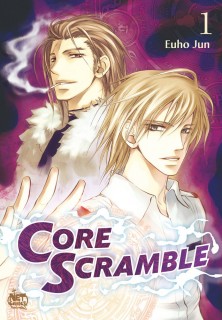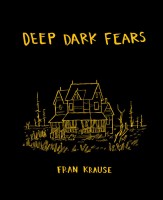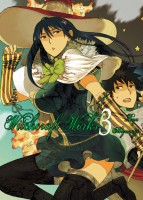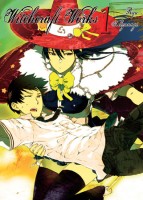My News and Reviews
It was entirely unintentional, but last week was apparently the week for sevens—both of my in-depth manga reviews last week were for the seventh installment of their respective series. They both happen to be manga currently licensed by Kodansha Comics, as well, which was also a coincidence. On Wednesday, I reviewed the seventh omnibus of Vinland Saga by Makoto Yukimura. The series continues to be magnificent. The seventh omnibus might be the last of the series to be released in English, which would truly be a shame. The volume does bring to a close one of the series’ major story arcs, but I really hope more of Vinland Saga will be able to be translated. The second review, part of my monthly horror manga review project, was of Yuki Urushibara’s Mushishi, Volume 7. Mushishi continues to be one of my favorite manga. I’m really enjoying my reread of the series and the opportunity to write about it in more detail. One other thing I wanted briefly to mention was a Kickstarter project to help Yamakiya Taiko, a wonderful youth taiko ensemble from Fukushima, raise money to defray the cost of their upcoming trip to the United States in March. I’ll actually be playing with the group a bit while they’re in Michigan, so I especially hope that the campaign succeeds.
Quick Takes
 Core Scramble, Volume 1 by Euho Jun. I’ve been slowly making my way through Netcomics’ new series which is what brought Core Scramble to my attention. That and the promise of boys’ love mixed with science fiction, fantasy, and action. At this point, romance doesn’t seem to be the priority of Core Scramble, though there is some sexual harassment thrown in. Chaeun is a fairly average soldier—one of many fighting in a war against swarms of extra-dimensional monsters invading the planet—but he has developed a knack for surviving situations that many seasoned veterans would consider hopeless. His tenacity has impressed his comrades as well as those who would like to take advantage of the invasion for their own purposes. The first volume of Core Scramble spends quite a bit of time establishing the series’ setting, explaining how the world’s magic, science, and inter-dimensional portals function and interact. Infodumps are a regular occurrence and break up the flow of the story itself, but I suspect that this shouldn’t be as much of an issue for the series’ later volumes. Granted, there are only two more.
Core Scramble, Volume 1 by Euho Jun. I’ve been slowly making my way through Netcomics’ new series which is what brought Core Scramble to my attention. That and the promise of boys’ love mixed with science fiction, fantasy, and action. At this point, romance doesn’t seem to be the priority of Core Scramble, though there is some sexual harassment thrown in. Chaeun is a fairly average soldier—one of many fighting in a war against swarms of extra-dimensional monsters invading the planet—but he has developed a knack for surviving situations that many seasoned veterans would consider hopeless. His tenacity has impressed his comrades as well as those who would like to take advantage of the invasion for their own purposes. The first volume of Core Scramble spends quite a bit of time establishing the series’ setting, explaining how the world’s magic, science, and inter-dimensional portals function and interact. Infodumps are a regular occurrence and break up the flow of the story itself, but I suspect that this shouldn’t be as much of an issue for the series’ later volumes. Granted, there are only two more.
 Deep Dark Fears by Fran Krause. What started out as a project to illustrate all of his irrational fears eventually evolved into an ongoing series of online comics in which Krause would not only draw his own fears but the fears submitted by his readers as well. Just over a hundred of those comics have now been brought together in the print collection of Deep Dark Fears, about half of them being newly published while the other half were selected by Krause as some of his favorites from online. While the subject matter can be disturbing and occasionally even grotesque, the comics themselves are actually quite charming. Krause doesn’t comment on or judge any of the fears but simply presents them as they are, irrational but still discomfiting whether they be based on known falsehoods learned as children or overactive imaginations as adults. Deep Dark Fears is a great collection of short comics about strange and bizarre fears. Some are only a single panel long while others may be a few pages, but they all leave an impression. I’m not sure if Krause has plans for additional print collections, but the series continues to grow online.
Deep Dark Fears by Fran Krause. What started out as a project to illustrate all of his irrational fears eventually evolved into an ongoing series of online comics in which Krause would not only draw his own fears but the fears submitted by his readers as well. Just over a hundred of those comics have now been brought together in the print collection of Deep Dark Fears, about half of them being newly published while the other half were selected by Krause as some of his favorites from online. While the subject matter can be disturbing and occasionally even grotesque, the comics themselves are actually quite charming. Krause doesn’t comment on or judge any of the fears but simply presents them as they are, irrational but still discomfiting whether they be based on known falsehoods learned as children or overactive imaginations as adults. Deep Dark Fears is a great collection of short comics about strange and bizarre fears. Some are only a single panel long while others may be a few pages, but they all leave an impression. I’m not sure if Krause has plans for additional print collections, but the series continues to grow online.
 Witchcraft Works, Volumes 3-7 by Ryu Mizunagi. Although I quite enjoyed the first two volumes of Witchcraft Works, I recently realized that I had fallen behind in actually reading the series. After catching up I can say that there are still things that I like about the manga, but I also find myself slightly less enamored with it than I once was. Primarily, I continue enjoy the reversal of stereotypical gender roles. If it wasn’t for that, I think the series would have bored me fairly quickly, even despite its other entertaining quirks. With the seemingly endless of author’s notes, it’s obvious that Mizunagi has put plenty of thought into the world of Witchcraft Works, but it isn’t always incorporated well into the story itself which is unfortunate. This seems to especially be a problem during the series’ battle and action-oriented story arcs where it feels like the characters spend more time explaining things they already know to one another rather than fighting, though they do eventually get around to that, too. Witchcraft Works is a great looking manga, though, Mizunagi’s visual style working wonders with all of the magic and mayhem. But ultimately, I think what I want is a little more substance to accompany all the spectacle.
Witchcraft Works, Volumes 3-7 by Ryu Mizunagi. Although I quite enjoyed the first two volumes of Witchcraft Works, I recently realized that I had fallen behind in actually reading the series. After catching up I can say that there are still things that I like about the manga, but I also find myself slightly less enamored with it than I once was. Primarily, I continue enjoy the reversal of stereotypical gender roles. If it wasn’t for that, I think the series would have bored me fairly quickly, even despite its other entertaining quirks. With the seemingly endless of author’s notes, it’s obvious that Mizunagi has put plenty of thought into the world of Witchcraft Works, but it isn’t always incorporated well into the story itself which is unfortunate. This seems to especially be a problem during the series’ battle and action-oriented story arcs where it feels like the characters spend more time explaining things they already know to one another rather than fighting, though they do eventually get around to that, too. Witchcraft Works is a great looking manga, though, Mizunagi’s visual style working wonders with all of the magic and mayhem. But ultimately, I think what I want is a little more substance to accompany all the spectacle.




